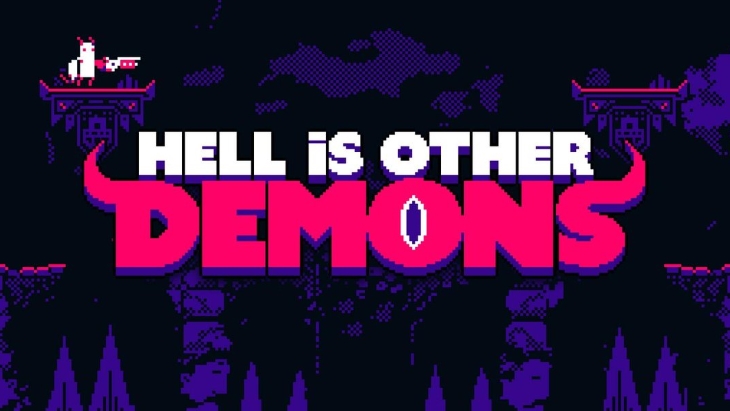
The term “Bullet Hell” is thrown around a lot. While specifically a sub-genre of shoot ‘em ups, it has become shorthand for “Oh God there are too many projectiles for me to dodge!” As absolute control is needed, you would suspect a platforming game with bullet hell elements would be incredibly tough. What goes up, must come down- and you can only move so far to the left and right so fast. Enter Hell is Other Demons; an arcade, platforming game with bullet hell elements. Is it worth rising to the challenge, or is this just blasphemy to multiple genres?
Hell is Other Demons
Publisher: Kongregate
Developer: Cuddle Monster Games
Platform: Windows PC, Nintendo Switch (Reviewed)
Release Date: May 20th (Windows PC) April 18th (Nintendo Switch)
Players: 1
Price: $9.99
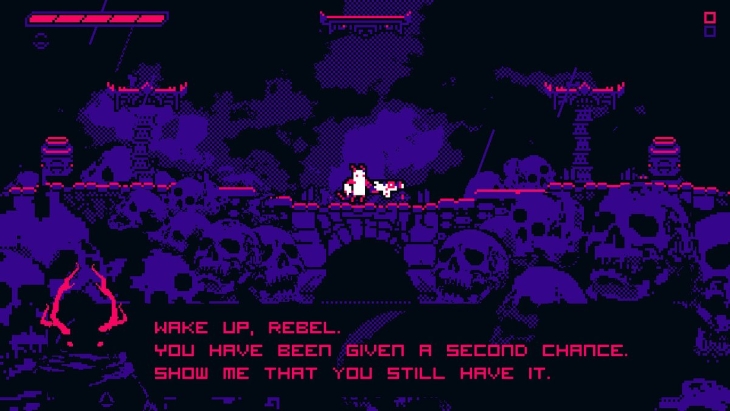
The premise is explained in a mere two paragraphs at the start of campaign mode. An invading force called “The Stale Supremacy” has brainwashed the demons of hell and effectively pulled off a coup, beating a resistance movement soundly.
Until your own demonic-self is revived to take care of the problem. If you are waiting for an in-depth look at how this hell functions or even the motives of the main villain, you will be waiting a long time. Thankfully plot is not intended to be the focus here, nor does it need to be.
Controls, much like the game itself, are simple to pick-up with a few intricacies to learn and master. You have access to a double jump, a dash that grants temporary invincibility, a stomp and can fire a weapon. Simply put, you clear out waves of enemies to progress to the next stage. You even get a small meter at the top of the screen to indicate how far through a wave you are, and how many waves there are in total.
Now, about those intricacies. In campaign mode, stages are selected on a map (unlocking paths by beating them). Here, the enemies will spawn in the same places in each wave. Even health and ultimate-attack ammo will drop after a set number of enemies die. Arcade mode on the other hand is a much less structured affair; with random enemies, stages and power-ups.
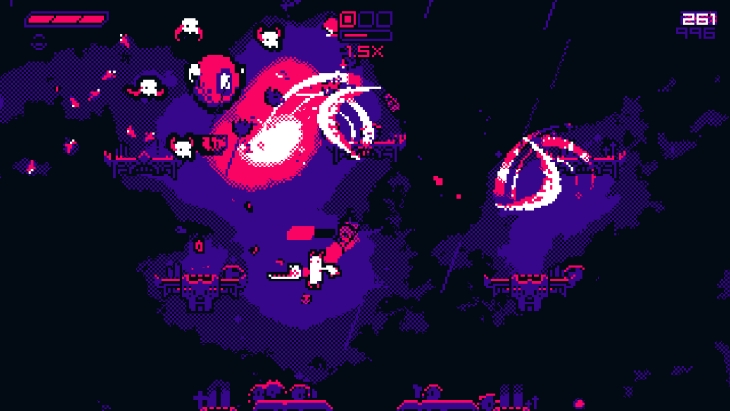
While this might seems it would making each stage easy to “solve”, it is far from the truth. A single wave can spawn multiple enemies at different times- even if you have not beaten the first load of enemies. The next wave starts when the last enemy of the previous wave dies, giving little time to sit on your laurels.
Each stage has a unique layout and can feature interesting gimmicks and traps. For example you may have a room with a low ceiling and a spiked roof, meaning you need to be more careful when bouncing off of enemies, or a level with an extremely high ceiling that you need to use rising platforms or bouncing on enemies to reach the upper-half. With each stage being unique, you play in a wide variety of ways to excel- such walking enemies straight into those aforementioned traps.
While the game is harsh but fair, there was the rare stage that would lean to heavily into a gimmick and would become dangerously close to being unfair. For example one level quickly fills with toxic water, forcing you to survive by constantly bouncing off enemies heads.
The issue is the first enemies take so long to spawn, you will take damage right off the bat no matter how well you time your jumps against the rising tide. Certainly an annoyance for certain challenges.
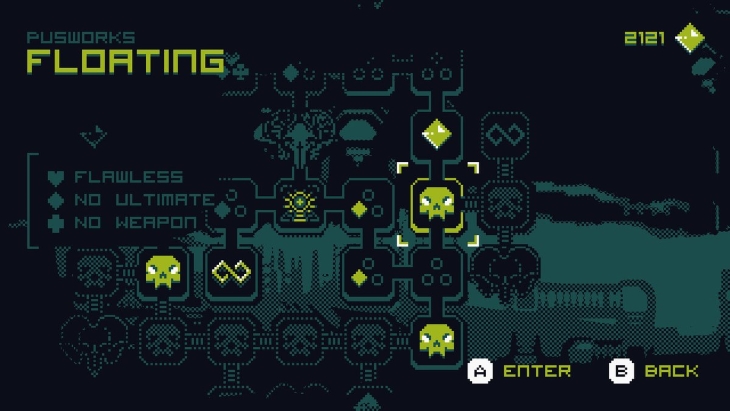
In campaign mode, each stage has three challenges. Completing the stage without firing a weapon (relying on stomping enemies for damage), completing without using an ultimate attack and completing without taking damage.
These are a fantastic way to encourage you to replay stages to earn more gems and build muscle-memory. In addition, the layouts and gimmicks of the various stages meant I had to strategize to succeed almost every time. You can replay stages as many times as you like, so there is not really a reason to attempt multiple challenges at once other than bragging rights.
On top of all these challenges on the surface level, you learn the finer points of the game. Or you would have, had it not been shown in loading screen tips. For things like being able to glide, or that you attract dropped money and power-ups when not shooting- it feels like something you should know from the start, or be able to learn as you play.
The random chance of seeing it via loading-screen tip undermines its importance and robs you of discovering it through experimentation. These tips can be turned off, of course. Thankfully some surprises are kept, like being able to double-jump after bouncing off an enemy’s head. That aside, having gems pulled toward you when not firing is a great way to discourage holding down shoot all the time, and encourages more considerate planning.
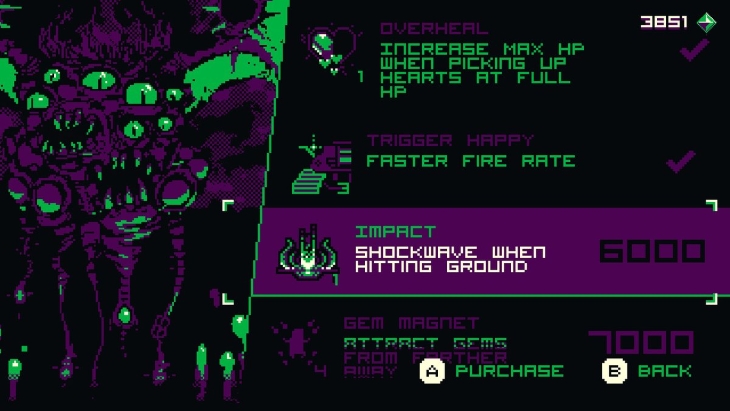
Before moving onto what you spend gems on, there is one quirk about them. When enemies die and explode into money, the gems will hang in the air for a brief moment, before crashing down to the ground. This also applies to healing items and ultimate attack ammo. This means it can easily land on spikes, traps and other things you do not wish to stand on or near.
Combined with how quickly the items despawn, it encourages the idea of hurling yourself into them before they vanish- especially health. The downside is that this reckless mentality usually puts you straight into the path of danger. When it comes down to split-second decision making, I would rather healing items be rarer or lasted longer than having to consider the risk of trying to stay alive.
To top off the depth of the challenge so far, gems can be spent on weapons and abilities to give you more options on how to tackle levels. These include grenade launches, guns that shoot behind you, extra health, dealing more damage when you land on foes and more. Gems are plentiful, but even when I felt I had “too much” money, opening up other stores soon showed me I was on the economic curve.
With challenges I often found myself tailoring my abilities to the task. There’s no point in having a weapon equipped when you do not want to fire it, and abilities based on taking damage or having more health are useless in a no-hit challenge. This frees you up for more unique combinations of abilities, which you may carry over into general play when challenging other stages.
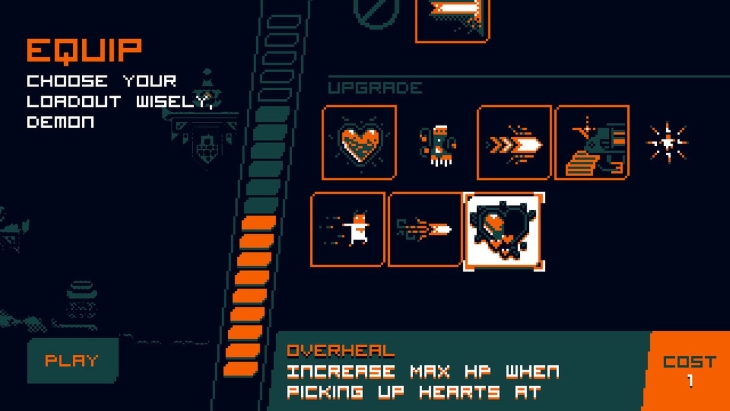
Your character has an “action point” cost. The weapon, ultimate attack and abilities you have cost various amounts of points. Increasing this limit costs gems. While being able to equip multiple abilities can make earlier stages easier, the gradual progression of power never made matters too easy for me.
As a brief aside, some stages are Endless stages. While there are no challenges here you can submit your score online, even without a Nintendo Switch Online Membership. Considering how even small bits of activity like this require the membership with other Nintendo Switch titles, I applaud it being allowed uninhibited here.
While the game exemplifies “git gud”, rapidly getting you back into the action when you die, there are a few issues that border on unfair. For example, you have extremely short i-frames after getting hit. With how many enemies and shots can be on screen, I personally felt it could have been a tad longer.
In one early area, you also find an enemy that shoots six shots in all directions that can home. While one on its own is not such an issue, dodging becomes very difficult when multiple enemies and especially multiple enemies of that kind are out at once. However, when this enemy appears later on, you usually have enough abilities by that point to make it a fairer fight.
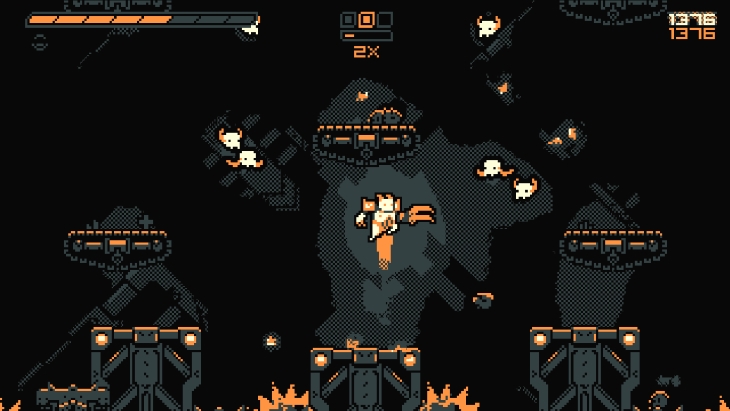
There is also an arcade mode separate from the campaign. You progress through random stages, earning a multiplier for killing enemies before you are hit. Every two stages you can pick a random weapon or ability, even sacrificing some of your score to re-roll your options.
While the campaign is a set of “puzzles”, enemy spawn locations are much more random here. Depending on your preferences, one mode will train you better for the other. Random weapons also drop in arcade mode- admittedly making your chance of success a little RNG based if you get a campaign-end game weapon for example. Then again, this also may come down to personal preference on which weapon you use best.
Arcade mode has a form of progression bar, filling up the better you do each time. These can unlock more characters to play as in arcade mode and even more color schemes (more on that later). While challenges and shops encourage replaying in challenge mode, this dangling carrot keeps you coming back for more.
The core gameplay is solid as a rock, and hard as one to boot. With two distinct game styles branching off of this- both equally realized and well made- the gameplay is sure to have something for anyone who wants a challenge, even ignoring very rare moments that could be deemed unfair.
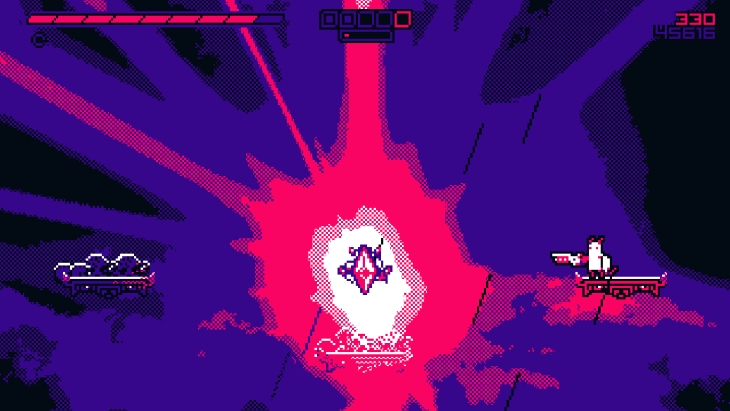
The graphics are something truly fascinating. Retro art-styles have been dragged through the mud when some implement them with little skill. The sprites are crisp and clearly defined, making it easy to tell enemies and platforms at a glance.
Simplistic but not basic, and with a clear effort put into the designs. What is most curious is the lighting effect. Essentially backgrounds and some explosions have a “dithered haze” around them. Despite a limited color pallet, this breaths life into limited animations.
Clouds and mist hang in the backgrounds of some stages, and there is a visible “pulse” to indicate where enemies will spawn. Nearly every object also has a soft haze or glow around them to help them stand-out from the often black background. It takes a game that would have been good looking, and makes it excellent.
There are moments where more details can be shown off and you can see the effort is still kept. From stages having details in the foreground, to giant bosses and shop-keeps in a heavy-metal-album-cover style making every piece of bone or flesh look twisted and gross. It all becomes readily clear the simplistic characters were purely an art-choice decision.
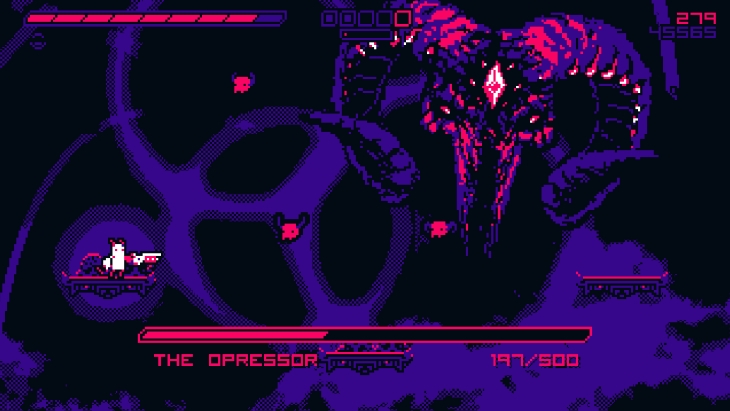
Each stage also looks unique for two reasons. Each stage divided up into one of four areas, with every asset in each of these stages being unique to that area. You may roll your eyes at seeing a factory and a sewer area for the umpteenth time in a video game, but they are well designed here nonetheless.
Each area also has a distinct color scheme. The color scheme at any given time uses roughly two colors (ignoring darker shades of those colors and black). Combined with the well made sprites, detail on larger pieces and the lighting and haze effects- it all comes together to be a very striking game that commands your attention. You can even change the color scheme to another once it is unlocked.
Something under the hood does not quite agree with the Nintendo Switch, however. I had multiple instances of hang during more intense moments- causing the action to briefly pause then resume even though I had total control with what I could not see for a split second.
It was rare, but occurred roughly once per session, but nearly an hour apart from each instance. Research into the PC version indicates it is not an issue there.
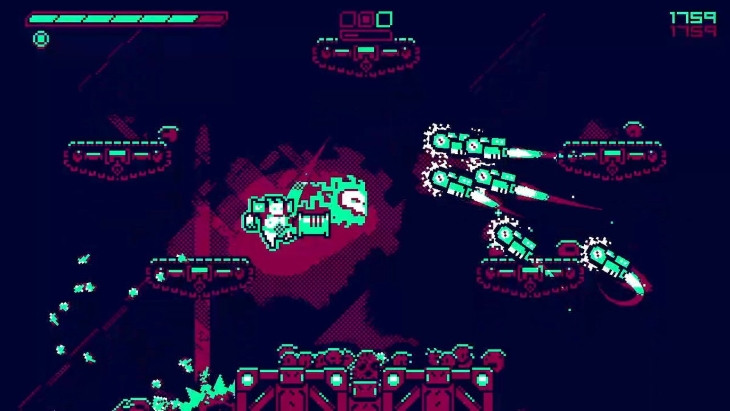
Even utilizing a synthwave style soundtrack, the game does not feel “80s”. In fact each piece is readily identifiable to the area or boss fight it comes from, fitting in perfectly. Some melodies may not be hummable off the top of your head and this may arguably be reinforced by hearing it over and over while playing, but tracks soon become recognizable within minutes of hearing them.
Nearly all the music sounds sinister and brooding, or overwhelming and intense. At times even elements of other electronic genres come into play such as techno, electro and even a little bit of bass you would typically associate with house. I am relived the soundtrack uses clear modern synths instead of using retro-sounding ones or attempting to ape a classic console. I really like chiptune, but the natural higher-pitch it tends to have would have ruined the mood here.
As you may expect, retro sound-effects are out in force. Much like the soundtrack, everything fits perfectly in place. Enemies die with a satisfying and crunchy “pop”, and everything sounds like it came straight from an old sound card. Particularly the sound of picking up gems- I swear I have heard it in another game. Perhaps a royalty free SFX pack, or just a very faithful recreation.
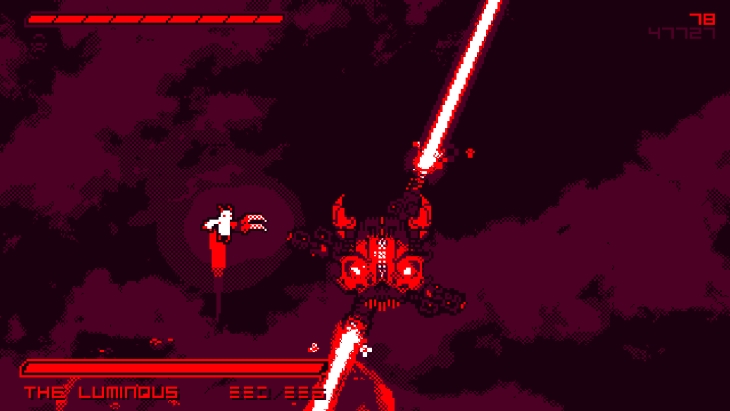
Hell is other Demons is the embodiment of a solid core that was built upon well. The gameplay is challenging, while offering more options to you on how you beat numerous styles of challenges.
Graphics are simple and retro, while using modern effects to expand upon it and make it a treat to look at. Audio takes inspiration from the past, while using modern techniques to turn it into something instantly suitable but not forgettable. With only a few missteps, this devil deserves its due.
Hell is Other Demons was reviewed on Nintendo Switch using a review copy provided by Kongregate. You can find additional information about Niche Gamer’s review/ethics policy here.